Strategic Plan Outline Report: Optus Australia, Business Analysis
VerifiedAdded on 2022/08/25
|22
|3782
|44
Report
AI Summary
This report presents a strategic plan outline for Optus Australia, a major telecommunications company in Australia. It begins with an introduction and assumptions about the industry, followed by an external analysis using PESTLE and Porter's Five Forces frameworks to assess the macro and micro environments. The report then analyzes Optus's competitors and stakeholders, including customers, investors, employees, communities, and government. An internal analysis is conducted using the balance scorecard, value chain analysis, VRIO, and SWOT analysis to evaluate Optus's mission, vision, goals, and long-term viability. The analysis highlights key industry success factors, competitive advantages, and potential threats and opportunities. The report concludes with a summary of findings and recommendations for Optus's strategic direction, emphasizing the importance of innovation, customer service, and adapting to the evolving telecommunications market.
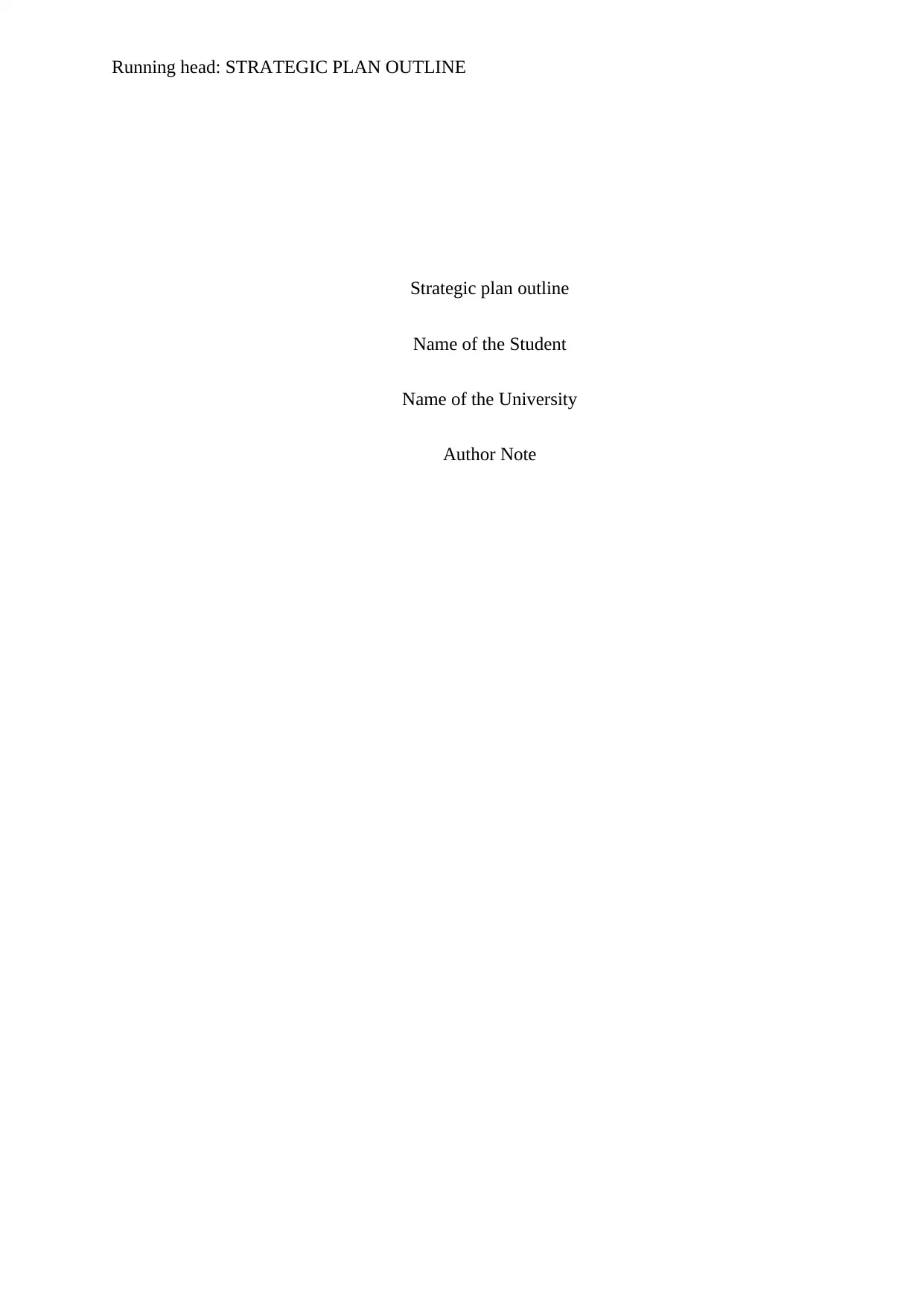
Running head: STRATEGIC PLAN OUTLINE
Strategic plan outline
Name of the Student
Name of the University
Author Note
Strategic plan outline
Name of the Student
Name of the University
Author Note
Paraphrase This Document
Need a fresh take? Get an instant paraphrase of this document with our AI Paraphraser
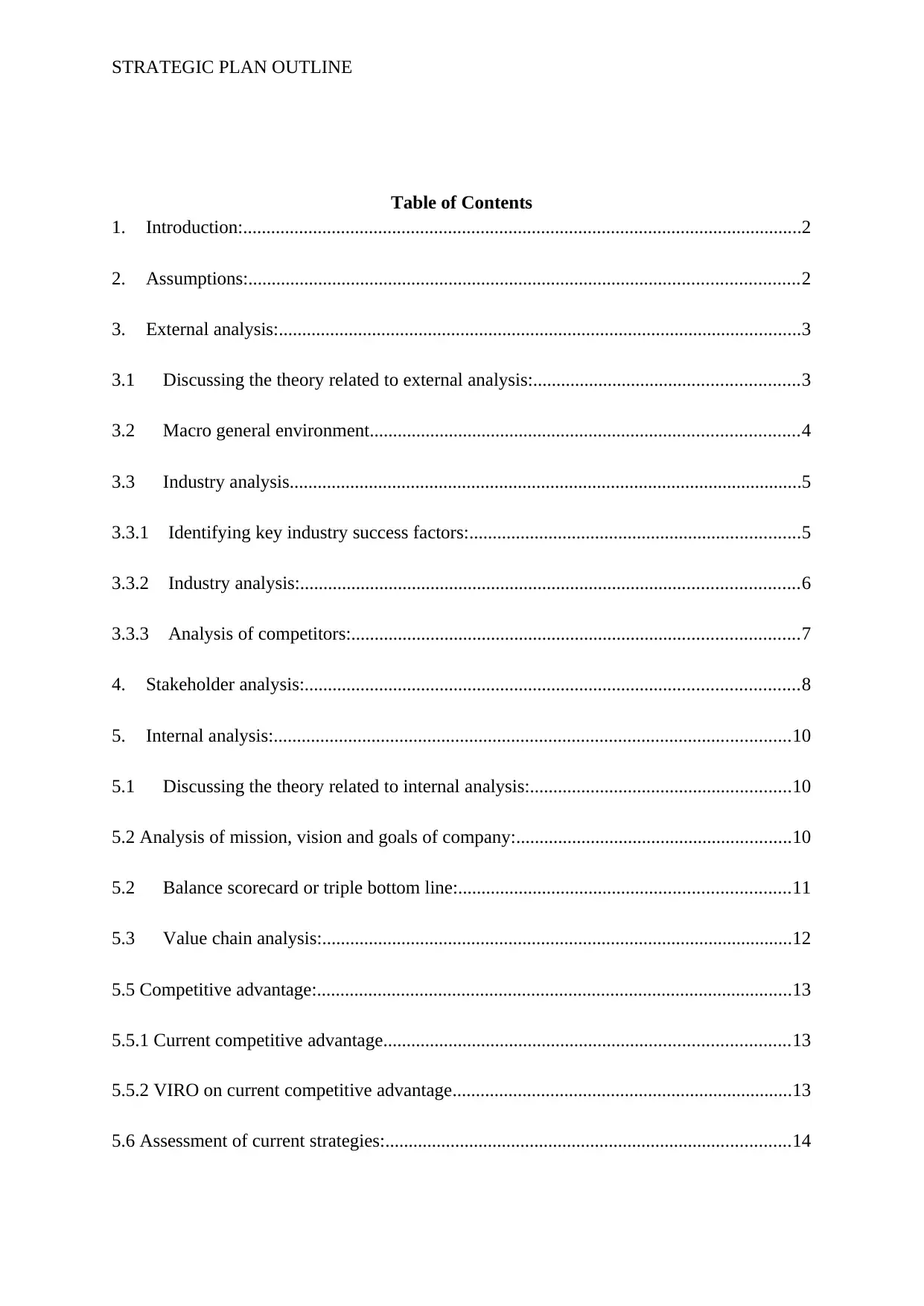
STRATEGIC PLAN OUTLINE
Table of Contents
1. Introduction:........................................................................................................................2
2. Assumptions:......................................................................................................................2
3. External analysis:................................................................................................................3
3.1 Discussing the theory related to external analysis:.........................................................3
3.2 Macro general environment............................................................................................4
3.3 Industry analysis..............................................................................................................5
3.3.1 Identifying key industry success factors:.......................................................................5
3.3.2 Industry analysis:...........................................................................................................6
3.3.3 Analysis of competitors:................................................................................................7
4. Stakeholder analysis:..........................................................................................................8
5. Internal analysis:...............................................................................................................10
5.1 Discussing the theory related to internal analysis:........................................................10
5.2 Analysis of mission, vision and goals of company:...........................................................10
5.2 Balance scorecard or triple bottom line:.......................................................................11
5.3 Value chain analysis:.....................................................................................................12
5.5 Competitive advantage:......................................................................................................13
5.5.1 Current competitive advantage.......................................................................................13
5.5.2 VIRO on current competitive advantage.........................................................................13
5.6 Assessment of current strategies:.......................................................................................14
Table of Contents
1. Introduction:........................................................................................................................2
2. Assumptions:......................................................................................................................2
3. External analysis:................................................................................................................3
3.1 Discussing the theory related to external analysis:.........................................................3
3.2 Macro general environment............................................................................................4
3.3 Industry analysis..............................................................................................................5
3.3.1 Identifying key industry success factors:.......................................................................5
3.3.2 Industry analysis:...........................................................................................................6
3.3.3 Analysis of competitors:................................................................................................7
4. Stakeholder analysis:..........................................................................................................8
5. Internal analysis:...............................................................................................................10
5.1 Discussing the theory related to internal analysis:........................................................10
5.2 Analysis of mission, vision and goals of company:...........................................................10
5.2 Balance scorecard or triple bottom line:.......................................................................11
5.3 Value chain analysis:.....................................................................................................12
5.5 Competitive advantage:......................................................................................................13
5.5.1 Current competitive advantage.......................................................................................13
5.5.2 VIRO on current competitive advantage.........................................................................13
5.6 Assessment of current strategies:.......................................................................................14
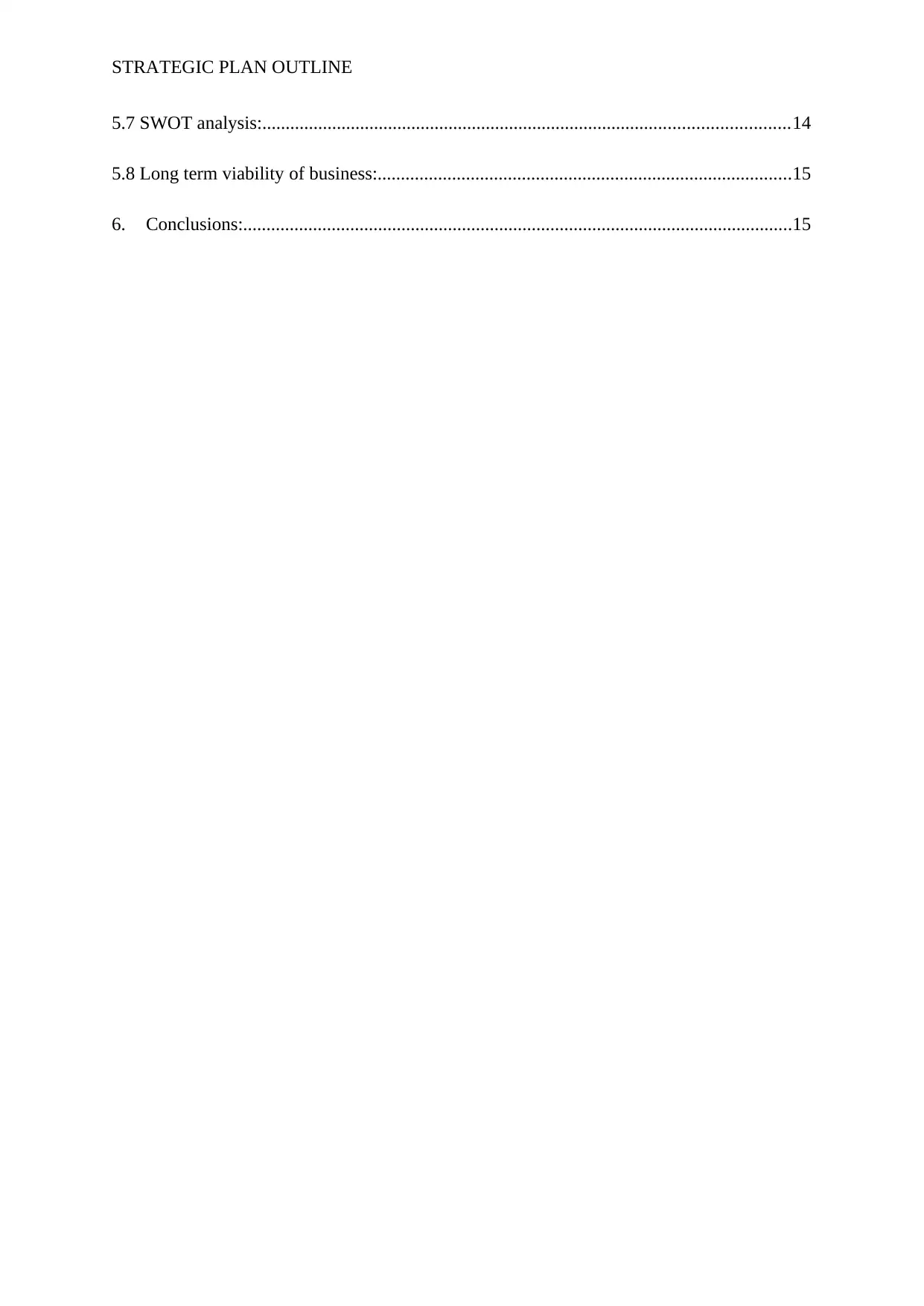
STRATEGIC PLAN OUTLINE
5.7 SWOT analysis:.................................................................................................................14
5.8 Long term viability of business:.........................................................................................15
6. Conclusions:......................................................................................................................15
5.7 SWOT analysis:.................................................................................................................14
5.8 Long term viability of business:.........................................................................................15
6. Conclusions:......................................................................................................................15
⊘ This is a preview!⊘
Do you want full access?
Subscribe today to unlock all pages.

Trusted by 1+ million students worldwide
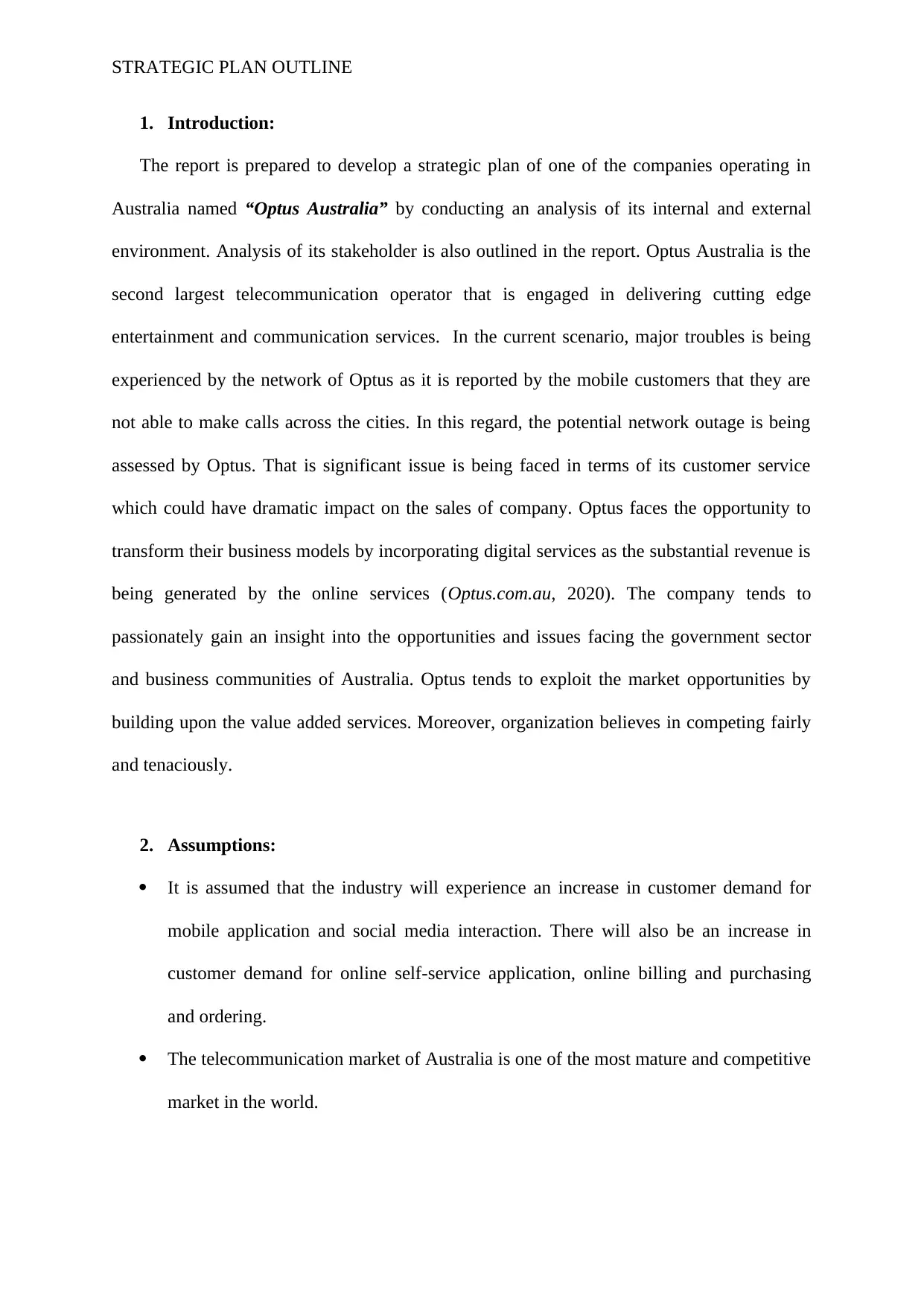
STRATEGIC PLAN OUTLINE
1. Introduction:
The report is prepared to develop a strategic plan of one of the companies operating in
Australia named “Optus Australia” by conducting an analysis of its internal and external
environment. Analysis of its stakeholder is also outlined in the report. Optus Australia is the
second largest telecommunication operator that is engaged in delivering cutting edge
entertainment and communication services. In the current scenario, major troubles is being
experienced by the network of Optus as it is reported by the mobile customers that they are
not able to make calls across the cities. In this regard, the potential network outage is being
assessed by Optus. That is significant issue is being faced in terms of its customer service
which could have dramatic impact on the sales of company. Optus faces the opportunity to
transform their business models by incorporating digital services as the substantial revenue is
being generated by the online services (Optus.com.au, 2020). The company tends to
passionately gain an insight into the opportunities and issues facing the government sector
and business communities of Australia. Optus tends to exploit the market opportunities by
building upon the value added services. Moreover, organization believes in competing fairly
and tenaciously.
2. Assumptions:
It is assumed that the industry will experience an increase in customer demand for
mobile application and social media interaction. There will also be an increase in
customer demand for online self-service application, online billing and purchasing
and ordering.
The telecommunication market of Australia is one of the most mature and competitive
market in the world.
1. Introduction:
The report is prepared to develop a strategic plan of one of the companies operating in
Australia named “Optus Australia” by conducting an analysis of its internal and external
environment. Analysis of its stakeholder is also outlined in the report. Optus Australia is the
second largest telecommunication operator that is engaged in delivering cutting edge
entertainment and communication services. In the current scenario, major troubles is being
experienced by the network of Optus as it is reported by the mobile customers that they are
not able to make calls across the cities. In this regard, the potential network outage is being
assessed by Optus. That is significant issue is being faced in terms of its customer service
which could have dramatic impact on the sales of company. Optus faces the opportunity to
transform their business models by incorporating digital services as the substantial revenue is
being generated by the online services (Optus.com.au, 2020). The company tends to
passionately gain an insight into the opportunities and issues facing the government sector
and business communities of Australia. Optus tends to exploit the market opportunities by
building upon the value added services. Moreover, organization believes in competing fairly
and tenaciously.
2. Assumptions:
It is assumed that the industry will experience an increase in customer demand for
mobile application and social media interaction. There will also be an increase in
customer demand for online self-service application, online billing and purchasing
and ordering.
The telecommunication market of Australia is one of the most mature and competitive
market in the world.
Paraphrase This Document
Need a fresh take? Get an instant paraphrase of this document with our AI Paraphraser
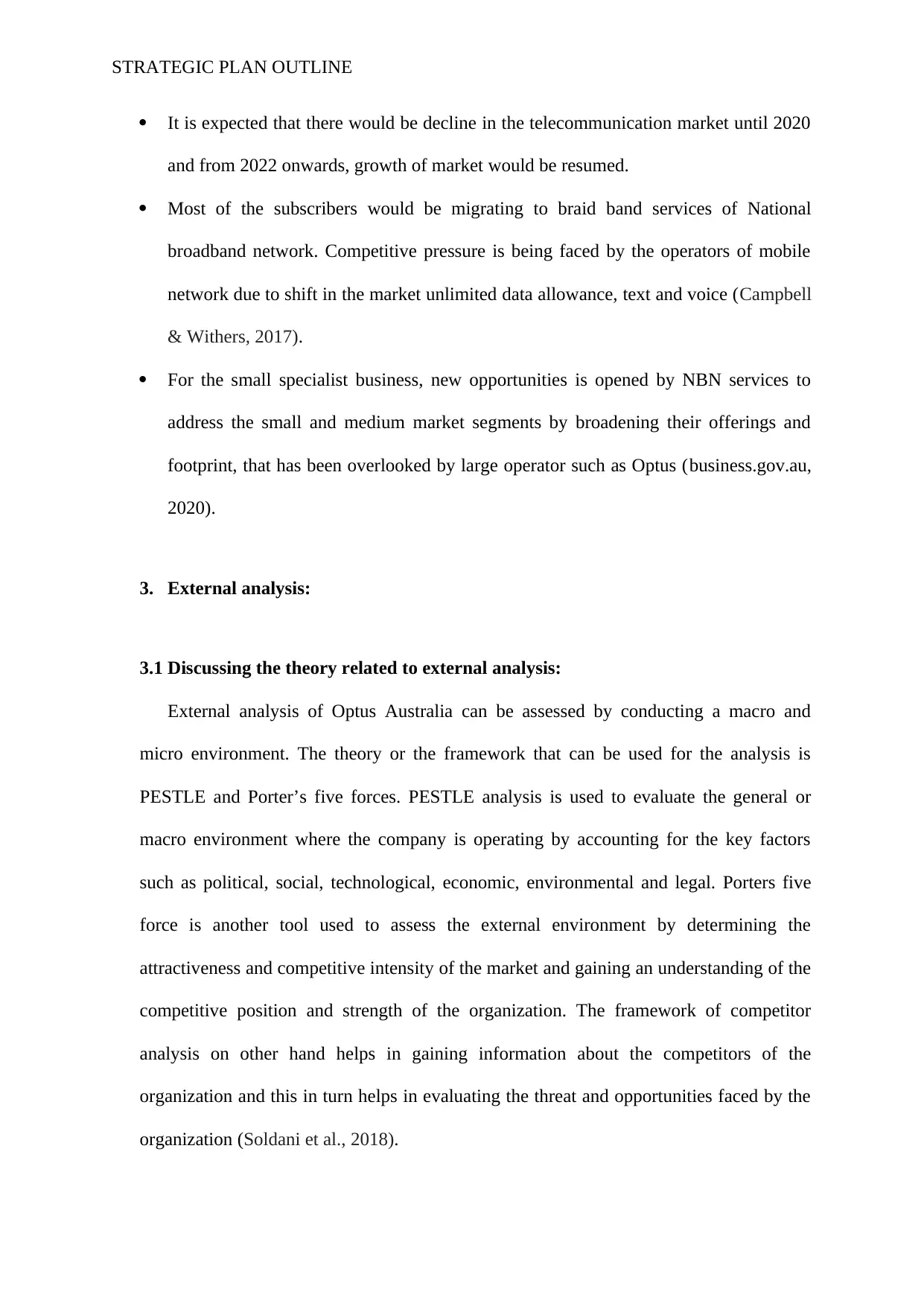
STRATEGIC PLAN OUTLINE
It is expected that there would be decline in the telecommunication market until 2020
and from 2022 onwards, growth of market would be resumed.
Most of the subscribers would be migrating to braid band services of National
broadband network. Competitive pressure is being faced by the operators of mobile
network due to shift in the market unlimited data allowance, text and voice (Campbell
& Withers, 2017).
For the small specialist business, new opportunities is opened by NBN services to
address the small and medium market segments by broadening their offerings and
footprint, that has been overlooked by large operator such as Optus (business.gov.au,
2020).
3. External analysis:
3.1 Discussing the theory related to external analysis:
External analysis of Optus Australia can be assessed by conducting a macro and
micro environment. The theory or the framework that can be used for the analysis is
PESTLE and Porter’s five forces. PESTLE analysis is used to evaluate the general or
macro environment where the company is operating by accounting for the key factors
such as political, social, technological, economic, environmental and legal. Porters five
force is another tool used to assess the external environment by determining the
attractiveness and competitive intensity of the market and gaining an understanding of the
competitive position and strength of the organization. The framework of competitor
analysis on other hand helps in gaining information about the competitors of the
organization and this in turn helps in evaluating the threat and opportunities faced by the
organization (Soldani et al., 2018).
It is expected that there would be decline in the telecommunication market until 2020
and from 2022 onwards, growth of market would be resumed.
Most of the subscribers would be migrating to braid band services of National
broadband network. Competitive pressure is being faced by the operators of mobile
network due to shift in the market unlimited data allowance, text and voice (Campbell
& Withers, 2017).
For the small specialist business, new opportunities is opened by NBN services to
address the small and medium market segments by broadening their offerings and
footprint, that has been overlooked by large operator such as Optus (business.gov.au,
2020).
3. External analysis:
3.1 Discussing the theory related to external analysis:
External analysis of Optus Australia can be assessed by conducting a macro and
micro environment. The theory or the framework that can be used for the analysis is
PESTLE and Porter’s five forces. PESTLE analysis is used to evaluate the general or
macro environment where the company is operating by accounting for the key factors
such as political, social, technological, economic, environmental and legal. Porters five
force is another tool used to assess the external environment by determining the
attractiveness and competitive intensity of the market and gaining an understanding of the
competitive position and strength of the organization. The framework of competitor
analysis on other hand helps in gaining information about the competitors of the
organization and this in turn helps in evaluating the threat and opportunities faced by the
organization (Soldani et al., 2018).
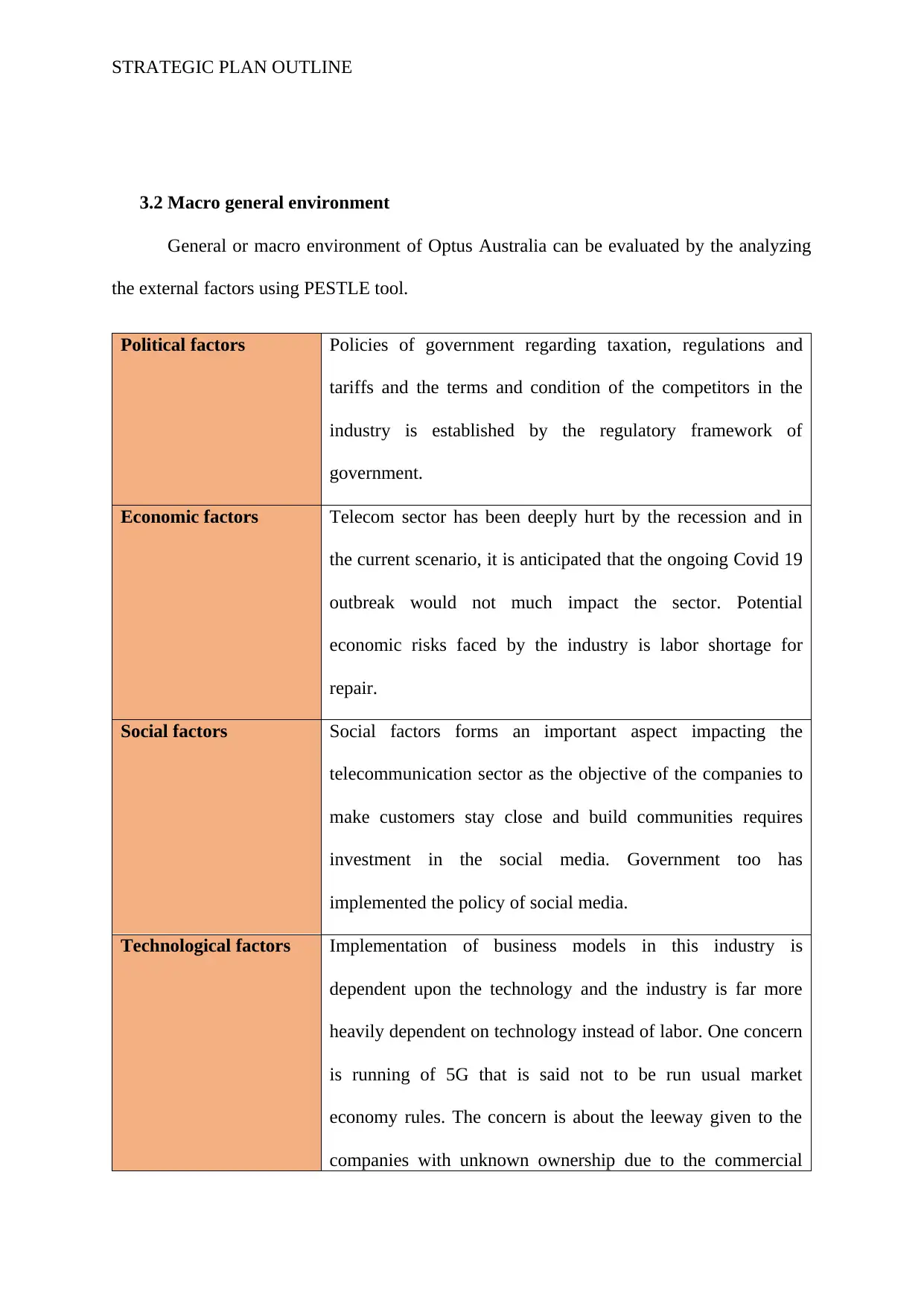
STRATEGIC PLAN OUTLINE
3.2 Macro general environment
General or macro environment of Optus Australia can be evaluated by the analyzing
the external factors using PESTLE tool.
Political factors Policies of government regarding taxation, regulations and
tariffs and the terms and condition of the competitors in the
industry is established by the regulatory framework of
government.
Economic factors Telecom sector has been deeply hurt by the recession and in
the current scenario, it is anticipated that the ongoing Covid 19
outbreak would not much impact the sector. Potential
economic risks faced by the industry is labor shortage for
repair.
Social factors Social factors forms an important aspect impacting the
telecommunication sector as the objective of the companies to
make customers stay close and build communities requires
investment in the social media. Government too has
implemented the policy of social media.
Technological factors Implementation of business models in this industry is
dependent upon the technology and the industry is far more
heavily dependent on technology instead of labor. One concern
is running of 5G that is said not to be run usual market
economy rules. The concern is about the leeway given to the
companies with unknown ownership due to the commercial
3.2 Macro general environment
General or macro environment of Optus Australia can be evaluated by the analyzing
the external factors using PESTLE tool.
Political factors Policies of government regarding taxation, regulations and
tariffs and the terms and condition of the competitors in the
industry is established by the regulatory framework of
government.
Economic factors Telecom sector has been deeply hurt by the recession and in
the current scenario, it is anticipated that the ongoing Covid 19
outbreak would not much impact the sector. Potential
economic risks faced by the industry is labor shortage for
repair.
Social factors Social factors forms an important aspect impacting the
telecommunication sector as the objective of the companies to
make customers stay close and build communities requires
investment in the social media. Government too has
implemented the policy of social media.
Technological factors Implementation of business models in this industry is
dependent upon the technology and the industry is far more
heavily dependent on technology instead of labor. One concern
is running of 5G that is said not to be run usual market
economy rules. The concern is about the leeway given to the
companies with unknown ownership due to the commercial
⊘ This is a preview!⊘
Do you want full access?
Subscribe today to unlock all pages.

Trusted by 1+ million students worldwide
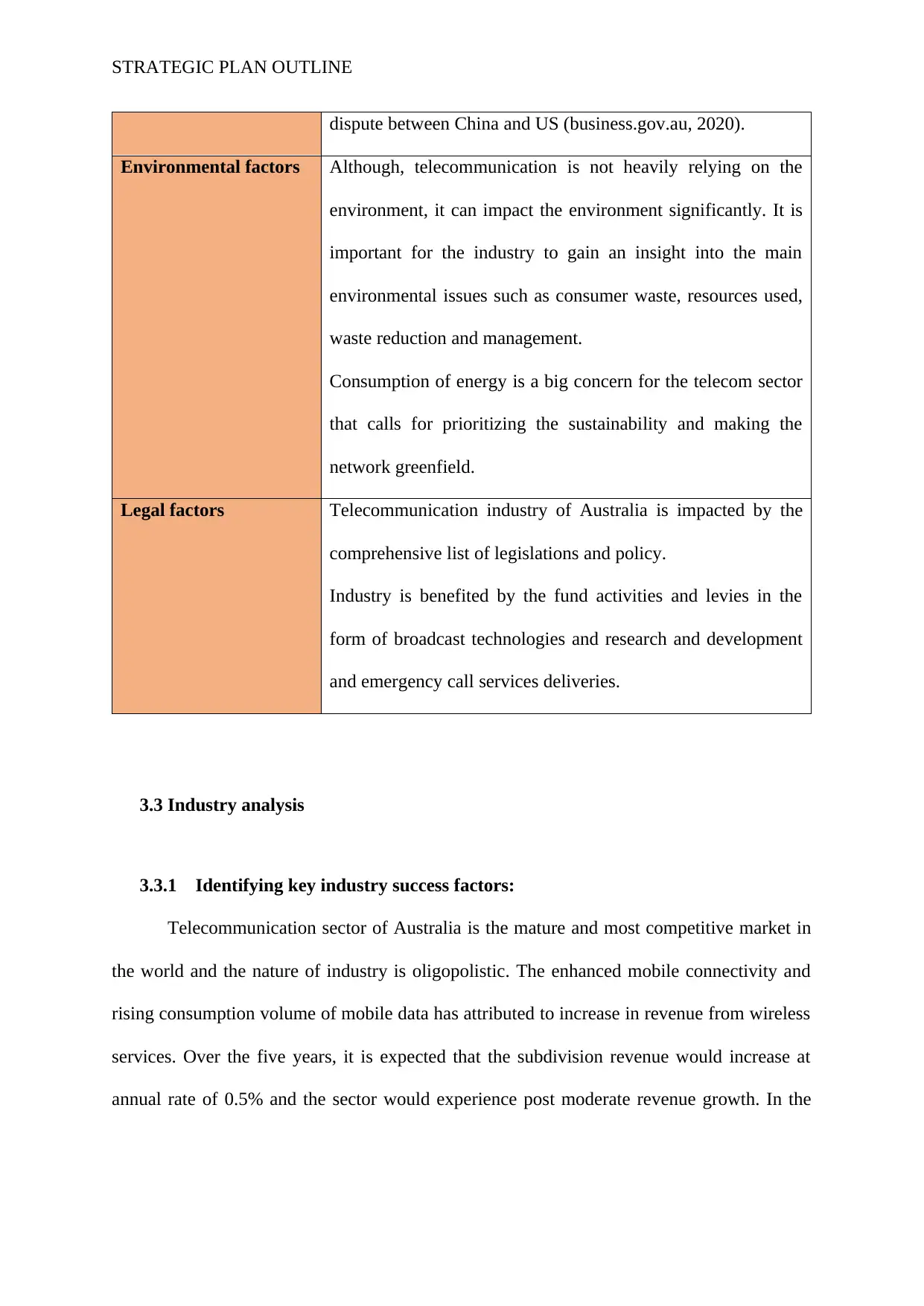
STRATEGIC PLAN OUTLINE
dispute between China and US (business.gov.au, 2020).
Environmental factors Although, telecommunication is not heavily relying on the
environment, it can impact the environment significantly. It is
important for the industry to gain an insight into the main
environmental issues such as consumer waste, resources used,
waste reduction and management.
Consumption of energy is a big concern for the telecom sector
that calls for prioritizing the sustainability and making the
network greenfield.
Legal factors Telecommunication industry of Australia is impacted by the
comprehensive list of legislations and policy.
Industry is benefited by the fund activities and levies in the
form of broadcast technologies and research and development
and emergency call services deliveries.
3.3 Industry analysis
3.3.1 Identifying key industry success factors:
Telecommunication sector of Australia is the mature and most competitive market in
the world and the nature of industry is oligopolistic. The enhanced mobile connectivity and
rising consumption volume of mobile data has attributed to increase in revenue from wireless
services. Over the five years, it is expected that the subdivision revenue would increase at
annual rate of 0.5% and the sector would experience post moderate revenue growth. In the
dispute between China and US (business.gov.au, 2020).
Environmental factors Although, telecommunication is not heavily relying on the
environment, it can impact the environment significantly. It is
important for the industry to gain an insight into the main
environmental issues such as consumer waste, resources used,
waste reduction and management.
Consumption of energy is a big concern for the telecom sector
that calls for prioritizing the sustainability and making the
network greenfield.
Legal factors Telecommunication industry of Australia is impacted by the
comprehensive list of legislations and policy.
Industry is benefited by the fund activities and levies in the
form of broadcast technologies and research and development
and emergency call services deliveries.
3.3 Industry analysis
3.3.1 Identifying key industry success factors:
Telecommunication sector of Australia is the mature and most competitive market in
the world and the nature of industry is oligopolistic. The enhanced mobile connectivity and
rising consumption volume of mobile data has attributed to increase in revenue from wireless
services. Over the five years, it is expected that the subdivision revenue would increase at
annual rate of 0.5% and the sector would experience post moderate revenue growth. In the
Paraphrase This Document
Need a fresh take? Get an instant paraphrase of this document with our AI Paraphraser
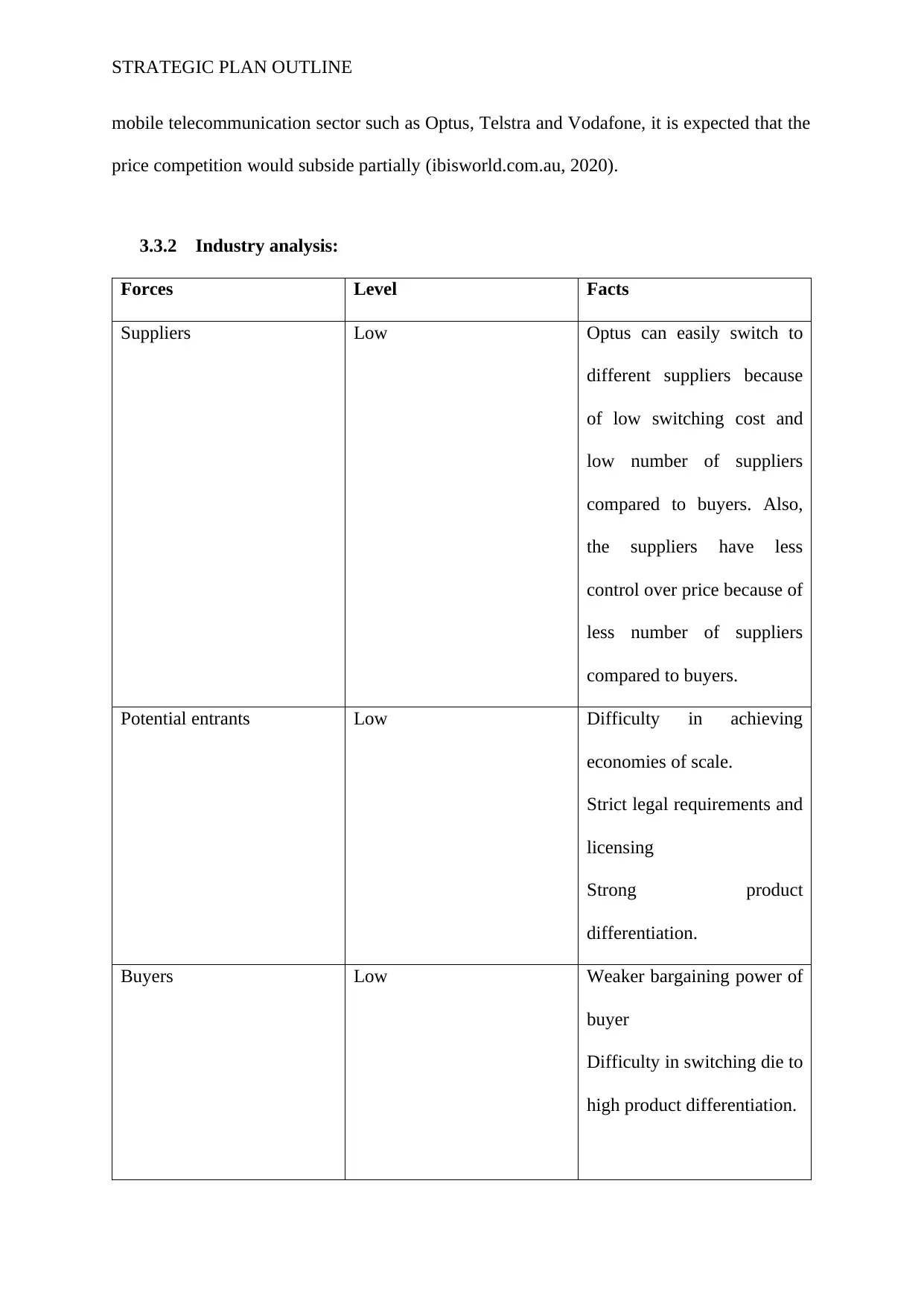
STRATEGIC PLAN OUTLINE
mobile telecommunication sector such as Optus, Telstra and Vodafone, it is expected that the
price competition would subside partially (ibisworld.com.au, 2020).
3.3.2 Industry analysis:
Forces Level Facts
Suppliers Low Optus can easily switch to
different suppliers because
of low switching cost and
low number of suppliers
compared to buyers. Also,
the suppliers have less
control over price because of
less number of suppliers
compared to buyers.
Potential entrants Low Difficulty in achieving
economies of scale.
Strict legal requirements and
licensing
Strong product
differentiation.
Buyers Low Weaker bargaining power of
buyer
Difficulty in switching die to
high product differentiation.
mobile telecommunication sector such as Optus, Telstra and Vodafone, it is expected that the
price competition would subside partially (ibisworld.com.au, 2020).
3.3.2 Industry analysis:
Forces Level Facts
Suppliers Low Optus can easily switch to
different suppliers because
of low switching cost and
low number of suppliers
compared to buyers. Also,
the suppliers have less
control over price because of
less number of suppliers
compared to buyers.
Potential entrants Low Difficulty in achieving
economies of scale.
Strict legal requirements and
licensing
Strong product
differentiation.
Buyers Low Weaker bargaining power of
buyer
Difficulty in switching die to
high product differentiation.
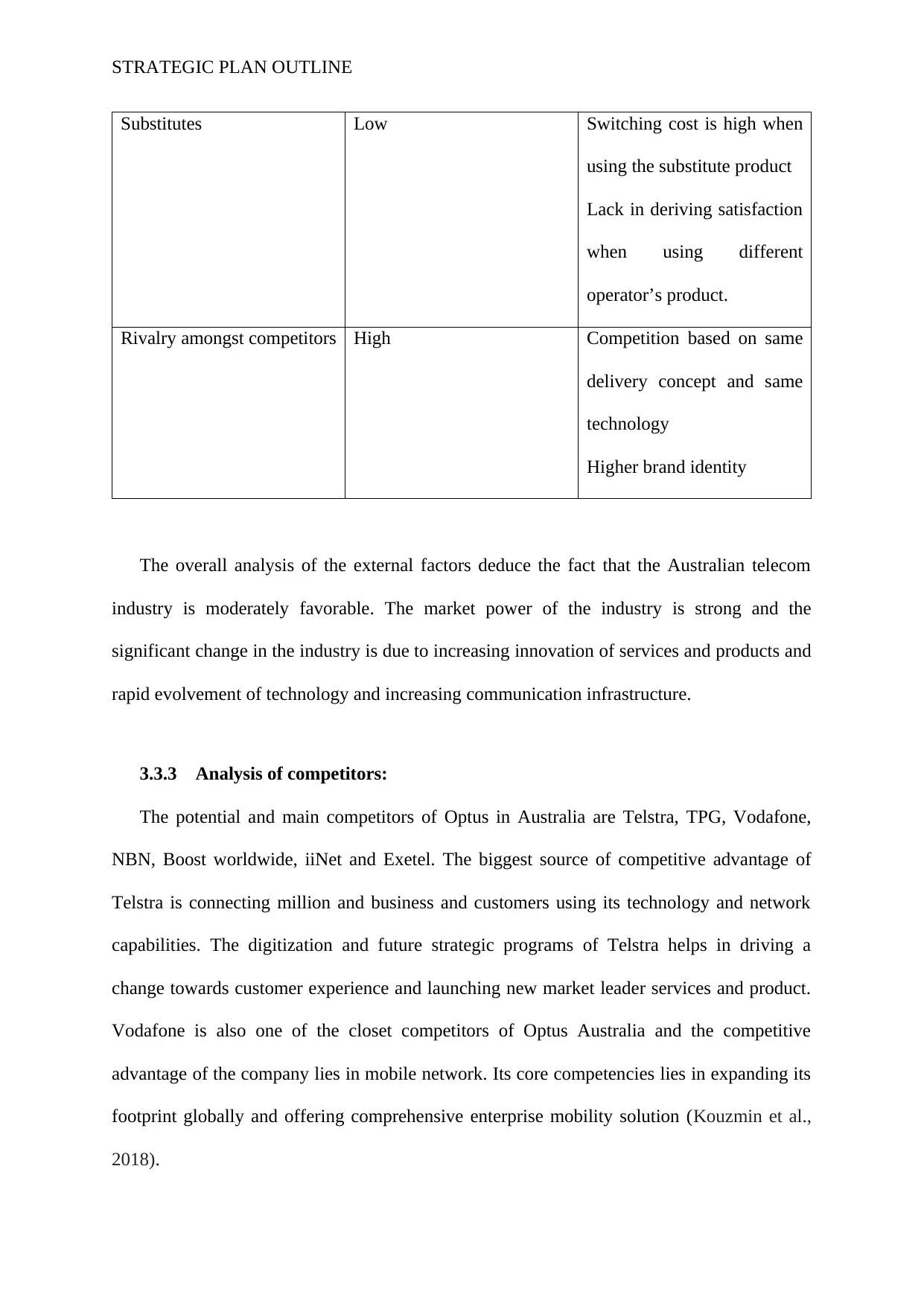
STRATEGIC PLAN OUTLINE
Substitutes Low Switching cost is high when
using the substitute product
Lack in deriving satisfaction
when using different
operator’s product.
Rivalry amongst competitors High Competition based on same
delivery concept and same
technology
Higher brand identity
The overall analysis of the external factors deduce the fact that the Australian telecom
industry is moderately favorable. The market power of the industry is strong and the
significant change in the industry is due to increasing innovation of services and products and
rapid evolvement of technology and increasing communication infrastructure.
3.3.3 Analysis of competitors:
The potential and main competitors of Optus in Australia are Telstra, TPG, Vodafone,
NBN, Boost worldwide, iiNet and Exetel. The biggest source of competitive advantage of
Telstra is connecting million and business and customers using its technology and network
capabilities. The digitization and future strategic programs of Telstra helps in driving a
change towards customer experience and launching new market leader services and product.
Vodafone is also one of the closet competitors of Optus Australia and the competitive
advantage of the company lies in mobile network. Its core competencies lies in expanding its
footprint globally and offering comprehensive enterprise mobility solution (Kouzmin et al.,
2018).
Substitutes Low Switching cost is high when
using the substitute product
Lack in deriving satisfaction
when using different
operator’s product.
Rivalry amongst competitors High Competition based on same
delivery concept and same
technology
Higher brand identity
The overall analysis of the external factors deduce the fact that the Australian telecom
industry is moderately favorable. The market power of the industry is strong and the
significant change in the industry is due to increasing innovation of services and products and
rapid evolvement of technology and increasing communication infrastructure.
3.3.3 Analysis of competitors:
The potential and main competitors of Optus in Australia are Telstra, TPG, Vodafone,
NBN, Boost worldwide, iiNet and Exetel. The biggest source of competitive advantage of
Telstra is connecting million and business and customers using its technology and network
capabilities. The digitization and future strategic programs of Telstra helps in driving a
change towards customer experience and launching new market leader services and product.
Vodafone is also one of the closet competitors of Optus Australia and the competitive
advantage of the company lies in mobile network. Its core competencies lies in expanding its
footprint globally and offering comprehensive enterprise mobility solution (Kouzmin et al.,
2018).
⊘ This is a preview!⊘
Do you want full access?
Subscribe today to unlock all pages.

Trusted by 1+ million students worldwide
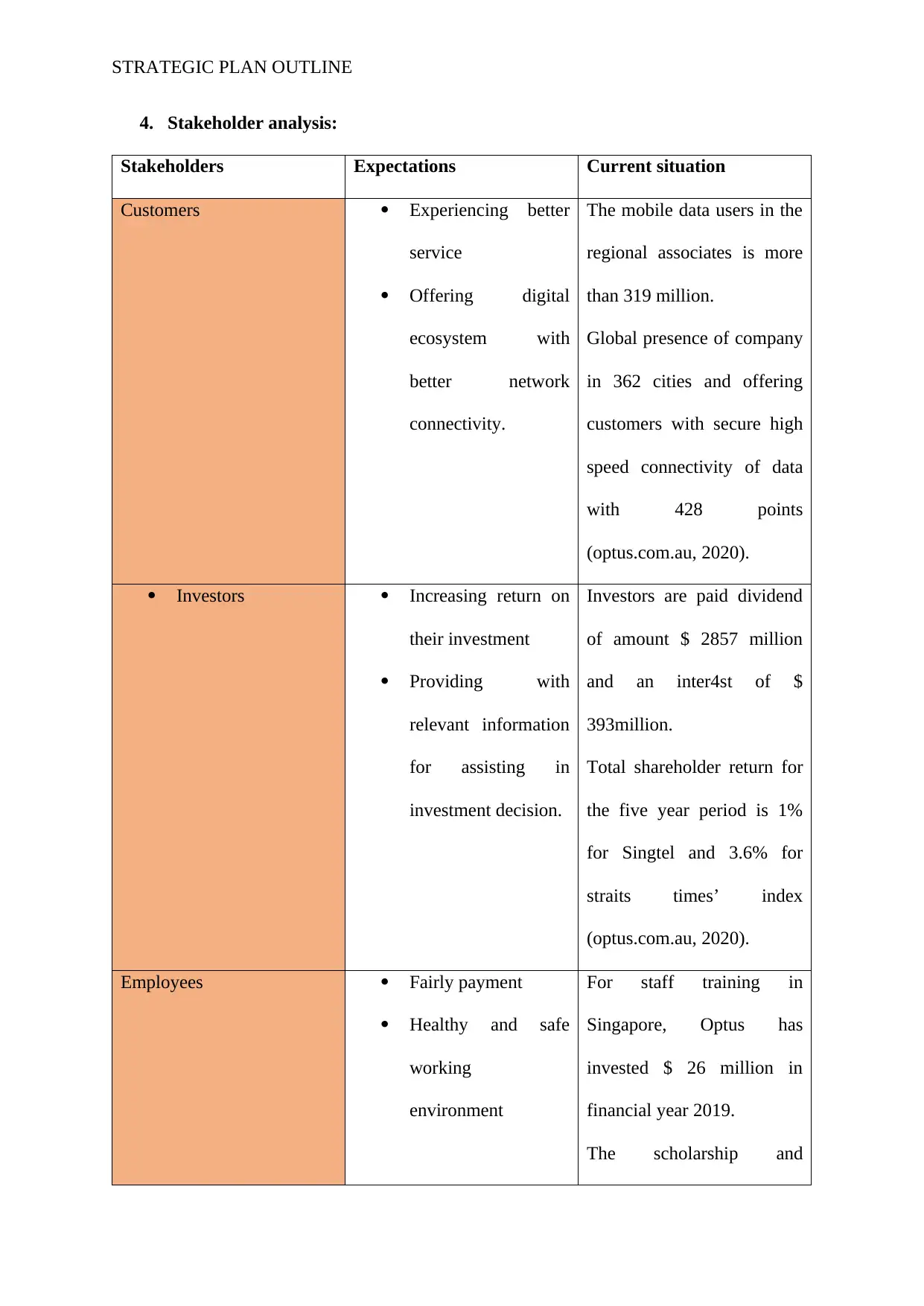
STRATEGIC PLAN OUTLINE
4. Stakeholder analysis:
Stakeholders Expectations Current situation
Customers Experiencing better
service
Offering digital
ecosystem with
better network
connectivity.
The mobile data users in the
regional associates is more
than 319 million.
Global presence of company
in 362 cities and offering
customers with secure high
speed connectivity of data
with 428 points
(optus.com.au, 2020).
Investors Increasing return on
their investment
Providing with
relevant information
for assisting in
investment decision.
Investors are paid dividend
of amount $ 2857 million
and an inter4st of $
393million.
Total shareholder return for
the five year period is 1%
for Singtel and 3.6% for
straits times’ index
(optus.com.au, 2020).
Employees Fairly payment
Healthy and safe
working
environment
For staff training in
Singapore, Optus has
invested $ 26 million in
financial year 2019.
The scholarship and
4. Stakeholder analysis:
Stakeholders Expectations Current situation
Customers Experiencing better
service
Offering digital
ecosystem with
better network
connectivity.
The mobile data users in the
regional associates is more
than 319 million.
Global presence of company
in 362 cities and offering
customers with secure high
speed connectivity of data
with 428 points
(optus.com.au, 2020).
Investors Increasing return on
their investment
Providing with
relevant information
for assisting in
investment decision.
Investors are paid dividend
of amount $ 2857 million
and an inter4st of $
393million.
Total shareholder return for
the five year period is 1%
for Singtel and 3.6% for
straits times’ index
(optus.com.au, 2020).
Employees Fairly payment
Healthy and safe
working
environment
For staff training in
Singapore, Optus has
invested $ 26 million in
financial year 2019.
The scholarship and
Paraphrase This Document
Need a fresh take? Get an instant paraphrase of this document with our AI Paraphraser
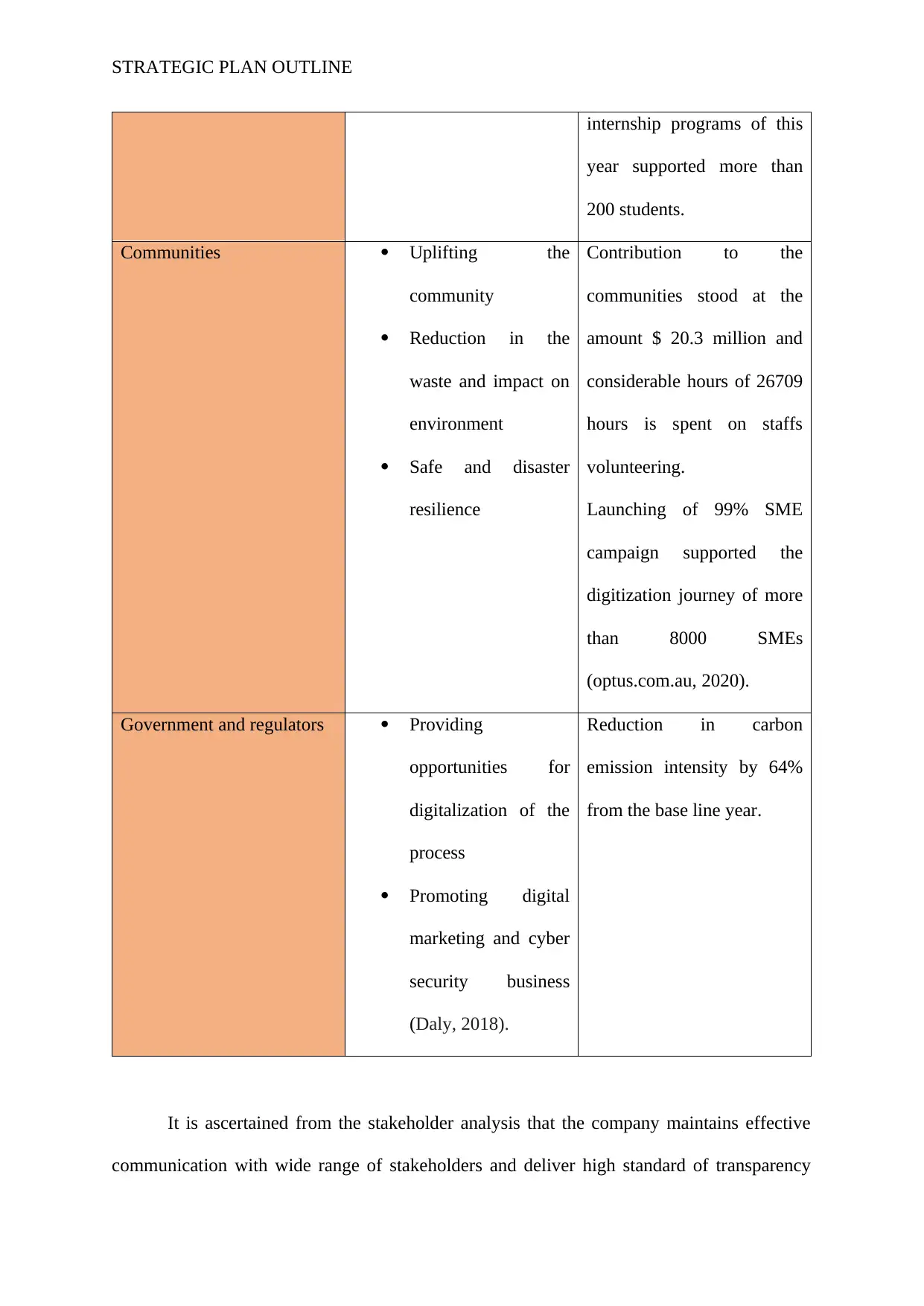
STRATEGIC PLAN OUTLINE
internship programs of this
year supported more than
200 students.
Communities Uplifting the
community
Reduction in the
waste and impact on
environment
Safe and disaster
resilience
Contribution to the
communities stood at the
amount $ 20.3 million and
considerable hours of 26709
hours is spent on staffs
volunteering.
Launching of 99% SME
campaign supported the
digitization journey of more
than 8000 SMEs
(optus.com.au, 2020).
Government and regulators Providing
opportunities for
digitalization of the
process
Promoting digital
marketing and cyber
security business
(Daly, 2018).
Reduction in carbon
emission intensity by 64%
from the base line year.
It is ascertained from the stakeholder analysis that the company maintains effective
communication with wide range of stakeholders and deliver high standard of transparency
internship programs of this
year supported more than
200 students.
Communities Uplifting the
community
Reduction in the
waste and impact on
environment
Safe and disaster
resilience
Contribution to the
communities stood at the
amount $ 20.3 million and
considerable hours of 26709
hours is spent on staffs
volunteering.
Launching of 99% SME
campaign supported the
digitization journey of more
than 8000 SMEs
(optus.com.au, 2020).
Government and regulators Providing
opportunities for
digitalization of the
process
Promoting digital
marketing and cyber
security business
(Daly, 2018).
Reduction in carbon
emission intensity by 64%
from the base line year.
It is ascertained from the stakeholder analysis that the company maintains effective
communication with wide range of stakeholders and deliver high standard of transparency
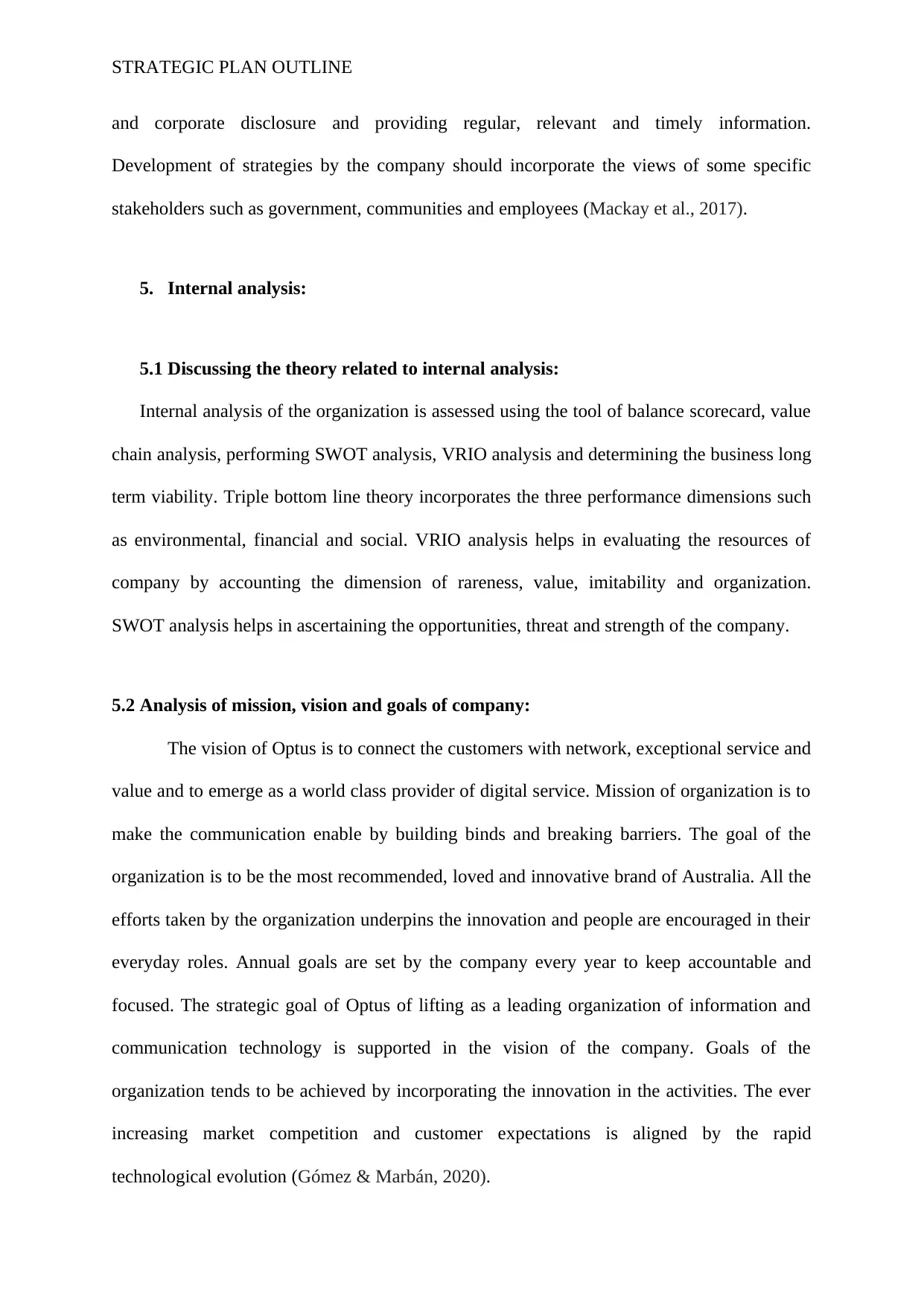
STRATEGIC PLAN OUTLINE
and corporate disclosure and providing regular, relevant and timely information.
Development of strategies by the company should incorporate the views of some specific
stakeholders such as government, communities and employees (Mackay et al., 2017).
5. Internal analysis:
5.1 Discussing the theory related to internal analysis:
Internal analysis of the organization is assessed using the tool of balance scorecard, value
chain analysis, performing SWOT analysis, VRIO analysis and determining the business long
term viability. Triple bottom line theory incorporates the three performance dimensions such
as environmental, financial and social. VRIO analysis helps in evaluating the resources of
company by accounting the dimension of rareness, value, imitability and organization.
SWOT analysis helps in ascertaining the opportunities, threat and strength of the company.
5.2 Analysis of mission, vision and goals of company:
The vision of Optus is to connect the customers with network, exceptional service and
value and to emerge as a world class provider of digital service. Mission of organization is to
make the communication enable by building binds and breaking barriers. The goal of the
organization is to be the most recommended, loved and innovative brand of Australia. All the
efforts taken by the organization underpins the innovation and people are encouraged in their
everyday roles. Annual goals are set by the company every year to keep accountable and
focused. The strategic goal of Optus of lifting as a leading organization of information and
communication technology is supported in the vision of the company. Goals of the
organization tends to be achieved by incorporating the innovation in the activities. The ever
increasing market competition and customer expectations is aligned by the rapid
technological evolution (Gómez & Marbán, 2020).
and corporate disclosure and providing regular, relevant and timely information.
Development of strategies by the company should incorporate the views of some specific
stakeholders such as government, communities and employees (Mackay et al., 2017).
5. Internal analysis:
5.1 Discussing the theory related to internal analysis:
Internal analysis of the organization is assessed using the tool of balance scorecard, value
chain analysis, performing SWOT analysis, VRIO analysis and determining the business long
term viability. Triple bottom line theory incorporates the three performance dimensions such
as environmental, financial and social. VRIO analysis helps in evaluating the resources of
company by accounting the dimension of rareness, value, imitability and organization.
SWOT analysis helps in ascertaining the opportunities, threat and strength of the company.
5.2 Analysis of mission, vision and goals of company:
The vision of Optus is to connect the customers with network, exceptional service and
value and to emerge as a world class provider of digital service. Mission of organization is to
make the communication enable by building binds and breaking barriers. The goal of the
organization is to be the most recommended, loved and innovative brand of Australia. All the
efforts taken by the organization underpins the innovation and people are encouraged in their
everyday roles. Annual goals are set by the company every year to keep accountable and
focused. The strategic goal of Optus of lifting as a leading organization of information and
communication technology is supported in the vision of the company. Goals of the
organization tends to be achieved by incorporating the innovation in the activities. The ever
increasing market competition and customer expectations is aligned by the rapid
technological evolution (Gómez & Marbán, 2020).
⊘ This is a preview!⊘
Do you want full access?
Subscribe today to unlock all pages.

Trusted by 1+ million students worldwide
1 out of 22
Related Documents
Your All-in-One AI-Powered Toolkit for Academic Success.
+13062052269
info@desklib.com
Available 24*7 on WhatsApp / Email
![[object Object]](/_next/static/media/star-bottom.7253800d.svg)
Unlock your academic potential
Copyright © 2020–2025 A2Z Services. All Rights Reserved. Developed and managed by ZUCOL.





